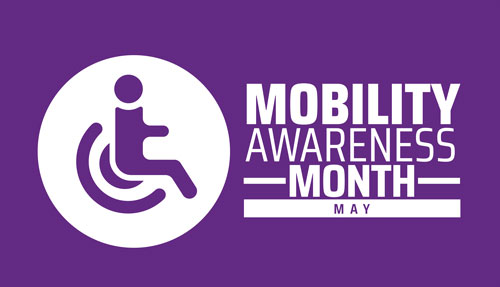May is Mobility Awareness Month, a time to highlight the experiences and achievements of Americans with mobility challenges and to consider how together, we can create a society in which accessibility for all is a foregone conclusion.
According to the Centers for Disease Control and Prevention, 12.2% of U.S. adults live with mobility limitations including significant difficulty walking and climbing stairs. Older adults are affected more frequently, especially those over 70 years of age.
While the Americans With Disability Act of 1990 led to important changes that enriched the lives of many people with disabilities, it did not go far enough. Sadly, some individuals who aren’t personally affected by mobility challenges aren’t aware that accessibility and equity are still major barriers for many people. They may not recognize that many businesses, institutions and city governments aren’t fully compliant with ADA requirements. And they may not know that lots of streets lack curb cuts, most subway and railroad stations don’t have ramps and working elevators, and plenty of stores, restaurants and entertainment venues don’t accommodate wheelchairs. Making matters worse, it’s usually left to people with mobility challenges to advocate for themselves.
In a 2022 NPR op ed, writer and wheelchair user Shruti Rajkumar quoted disability advocates David Capozzi and Sandy Ho.
“There are no ‘ADA police’,” said Capozzi. Therefore, “complaints of inaccessibility and ADA violations have to be filed with agencies such as the Equal Employment Opportunity Commission and the Department of Justice.”
Added Ho: “It is still the burden, the expectation, [and] the responsibility of disabled people, people in the disability community to bring up the ADA and accommodations that are not meeting basic requirements.”
During Mobility Awareness Month, we must add our voices to the voices of disabled people, so their demands will be heard loud and clear.
How do we do this?
1. Share stories of disabled people.
People respond better to storytelling than promotions of other kinds. During May and beyond, share your story or the story of a disabled loved one on social media so that others discover that accessibility remains a significant issue for those with mobility challenges.
2. Support disability organizations
Learn about organizations that are advocating for equity and accessibility. Get involved by volunteering or donating to those organizations. Here’s a list to get you started.
3. Support businesses that accommodate individuals with mobility challenges
If you know of restaurants or shops in your area that center the needs of disabled people either by hiring them or making their facilities accessible, frequent those establishments whenever possible.
4. Raise your own consciousness
Don’t wait for disabled individuals to teach you about their experiences. Educate yourself by reading, volunteering and paying attention to your surroundings and the ways in which they may unintentionally exclude participation of people with mobility challenges.
5. Participate in a “Walk and Roll” event
According to SETWorks, “a walk-n-roll is an age- and ability-inclusive event to raise funds for mobility-related organizations. Participants can join in by running, walking, rolling, or moving in any way. These events also serve as an opportunity for education and building connections within the community.” Check out organizations like Free Wheelchair Mission’s Move for Mobility, Ehlers-Danlos Society’s Walk and Roll or Cure SMA (spinal muscular atrophy) events for more information.


